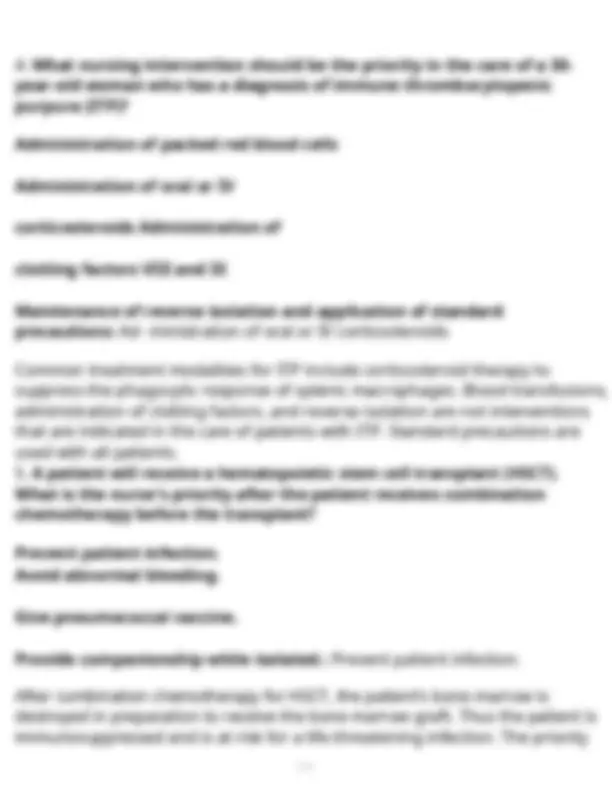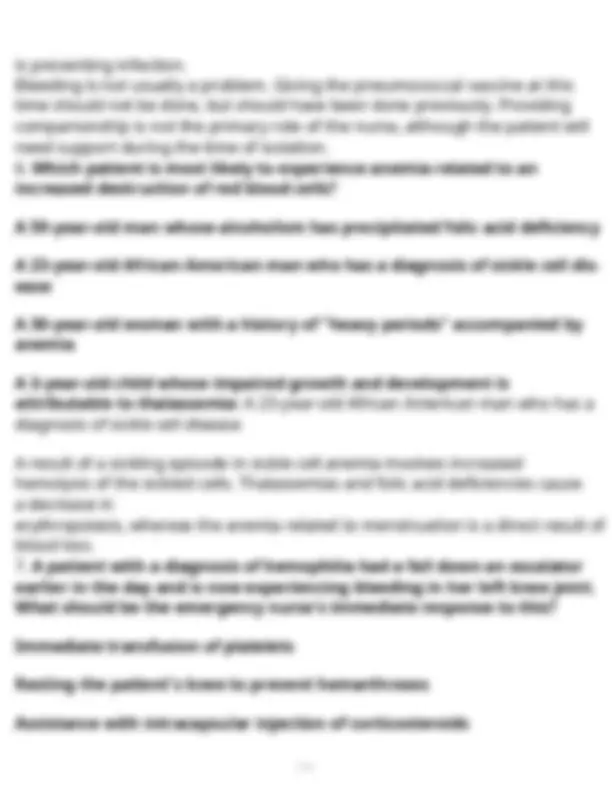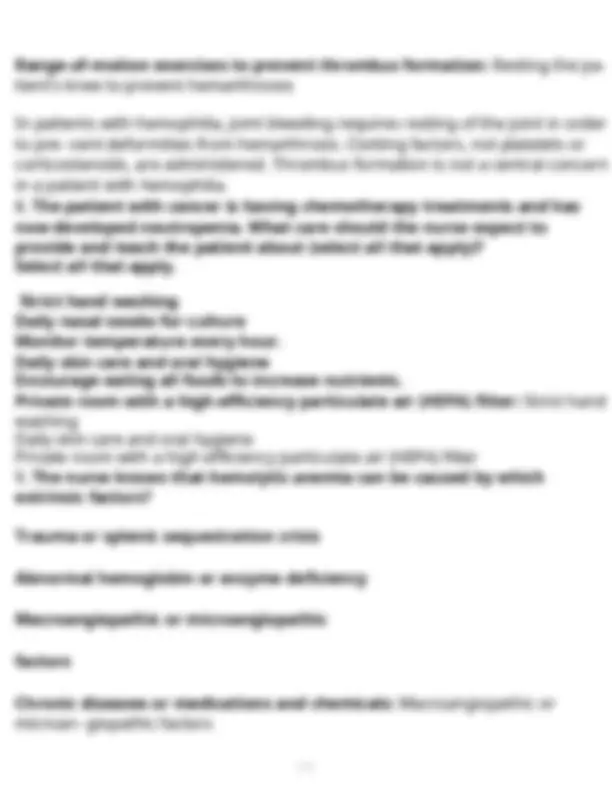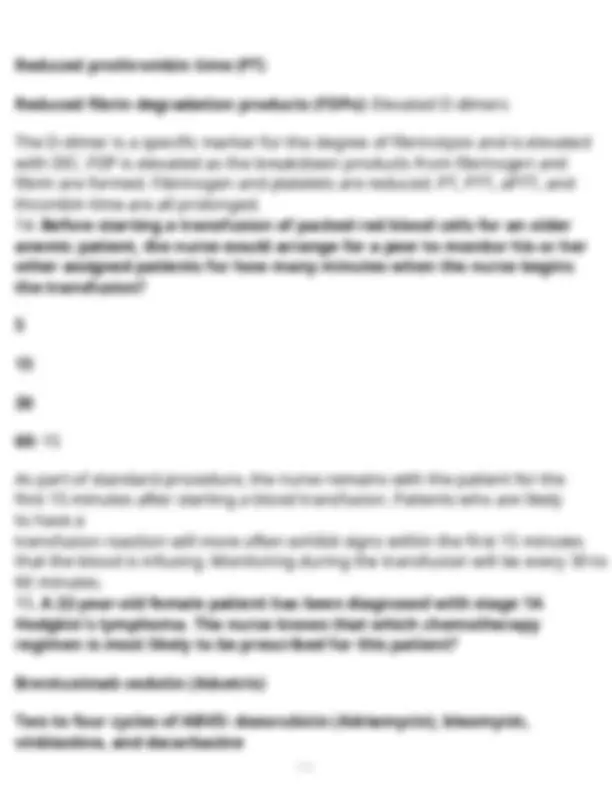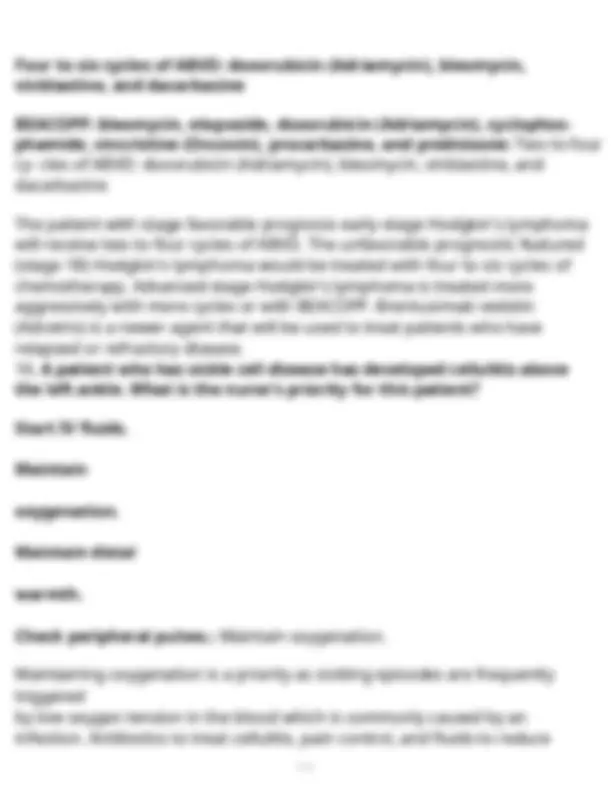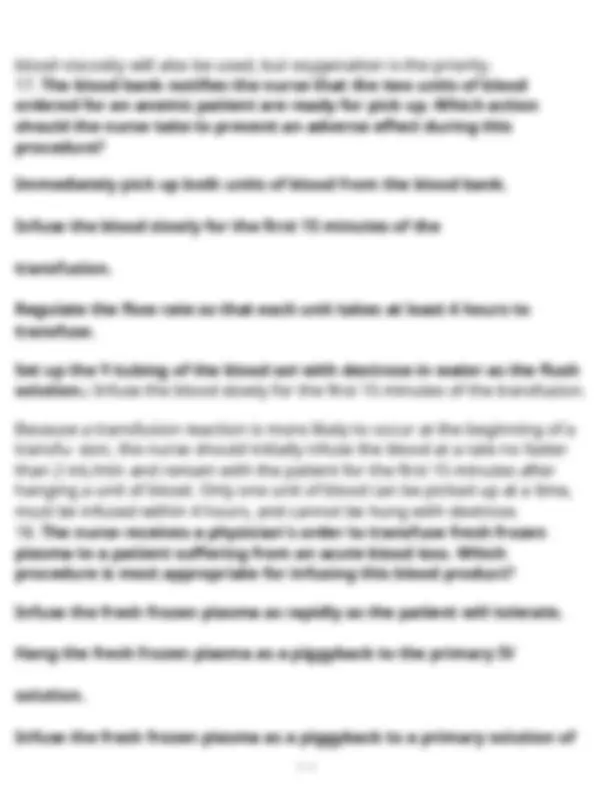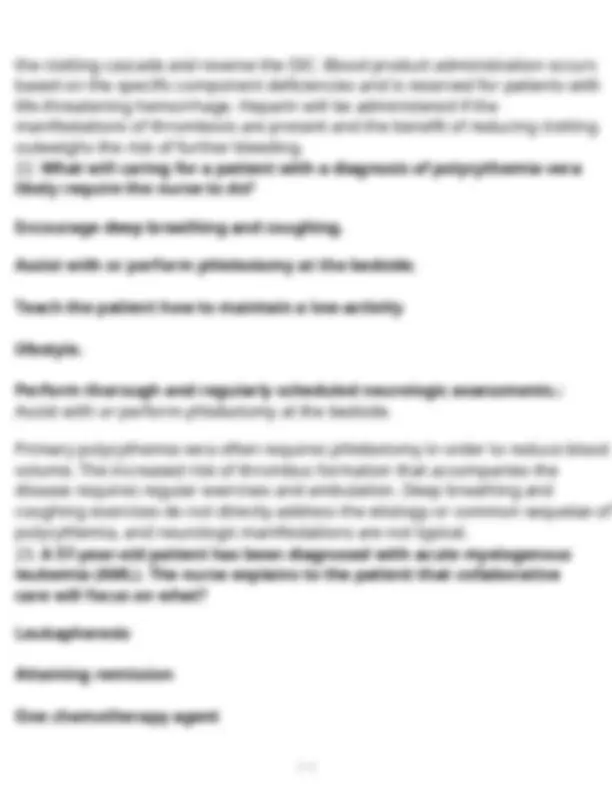Download Evolve Hematologic Problems NCLEX Questions already grade A+ [NEWEST] and more Exams Nursing in PDF only on Docsity!
Evolve Hematologic Problems NCLEX Questions
already grade A+ [NEWEST]
- The patient is being treated for non-Hodgkin's lymphoma (NHL). What should the nurse first teach the patient about the treatment? Skin care that will be needed Method of obtaining the treatment Gastrointestinal tract effects of treatment Treatment type and expected side effects: Treatment type and expected side effects The patient should first be taught about the type of treatment and the expected and potential side effects. Nursing care is related to the area affected by the disease and treatment. Skin care will be affected if radiation is used. Not all patients will have gastrointestinal tract effects of NHL or treatment. The method of obtaining treatment will be included in the teaching about the type of treatment.
- An older patient relates that she has increased fatigue and a headache. The nurse identifies pale skin and glossitis on assessment. In response to these findings, which teaching will be helpful to the patient if she has microcytic, hypochromic anemia? Take enteric-coated iron with each meal.
Take cobalamin with green leafy vegetables. Take the iron with orange juice one hour before meals. Decrease the intake of the antiseizure medications to improve.: Take the iron with orange juice one hour before meals. With microcytic, hypochromic anemia, there may be an iron, B6, or copper deficien- cy, thalassemia, or lead poisoning. The iron prescribed should be taken with orange juice one hour before meals as it is best absorbed in an acid environment. Mega- loblastic anemias occur with cobalamin (vitamin B12) and folic acid deficiencies. Vitamin B12 may help RBC maturation if the patient has the intrinsic factor in the stomach. Green leafy vegetables provide folic acid for RBC maturation. Antiseizure drugs may contribute to aplastic anemia or folic acid deficiency, but the patient should not stop taking the medications. Changes in medications will be prescribed by the health care provider.
- The nurse notes a physician's order written at 10:00 AM for two units of packed red blood cells to be administered to a patient who is anemic as a result of chronic blood loss. If the transfusion is picked up at 11: AM, the nurse should plan to hang the unit no later than what time? 11:45 AM 12:00 noon 12:30 PM 3:30 PM: 12:00 noon The nurse must hang the unit of packed red blood cells within 30 minutes of signing them out from the blood bank.
is preventing infection. Bleeding is not usually a problem. Giving the pneumococcal vaccine at this time should not be done, but should have been done previously. Providing companionship is not the primary role of the nurse, although the patient will need support during the time of isolation.
- Which patient is most likely to experience anemia related to an increased destruction of red blood cells? A 59-year-old man whose alcoholism has precipitated folic acid deficiency A 23-year-old African American man who has a diagnosis of sickle cell dis- ease A 30-year-old woman with a history of "heavy periods" accompanied by anemia A 3-year-old child whose impaired growth and development is attributable to thalassemia: A 23-year-old African American man who has a diagnosis of sickle cell disease A result of a sickling episode in sickle cell anemia involves increased hemolysis of the sickled cells. Thalassemias and folic acid deficiencies cause a decrease in erythropoiesis, whereas the anemia related to menstruation is a direct result of blood loss.
- A patient with a diagnosis of hemophilia had a fall down an escalator earlier in the day and is now experiencing bleeding in her left knee joint. What should be the emergency nurse's immediate response to this? Immediate transfusion of platelets Resting the patient's knee to prevent hemarthroses Assistance with intracapsular injection of corticosteroids
Range-of-motion exercises to prevent thrombus formation: Resting the pa- tient's knee to prevent hemarthroses In patients with hemophilia, joint bleeding requires resting of the joint in order to pre- vent deformities from hemarthrosis. Clotting factors, not platelets or corticosteroids, are administered. Thrombus formation is not a central concern in a patient with hemophilia.
- The patient with cancer is having chemotherapy treatments and has now developed neutropenia. What care should the nurse expect to provide and teach the patient about (select all that apply)? Select all that apply. Strict hand washing Daily nasal swabs for culture Monitor temperature every hour. Daily skin care and oral hygiene Encourage eating all foods to increase nutrients. Private room with a high-efficiency particulate air (HEPA) filter: Strict hand washing Daily skin care and oral hygiene Private room with a high-efficiency particulate air (HEPA) filter
- The nurse knows that hemolytic anemia can be caused by which extrinsic factors? Trauma or splenic sequestration crisis Abnormal hemoglobin or enzyme deficiency Macroangiopathic or microangiopathic factors Chronic diseases or medications and chemicals: Macroangiopathic or microan- giopathic factors
Abdominal pain: Fatigue The patient with a low hemoglobin and hematocrit is anemic and would be most likely to experience fatigue. Fatigue develops because of the lowered oxygen-carrying capacity that leads to reduced tissue oxygenation to carry out cellular functions. Thirst, headache, and abdominal pain are not related to anemia.
- When preparing to administer an ordered blood transfusion, which IV solution does the nurse use when priming the blood tubing? Lactated Ringer's 5% dextrose in water 0.9% sodium chloride 0.45% sodium chloride: 0.9% sodium chloride The blood set should be primed before the transfusion with 0.9% sodium chloride, also known as normal saline. It is also used to flush the blood tubing after the infusion is complete to ensure the patient receives blood that is left in the tubing when the bag is empty. Dextrose and lactated Ringer's solutions cannot be used with blood as they will cause RBC hemolysis.
- The patient with leukemia has acute disseminated intravascular coagula- tion (DIC) and is bleeding. What diagnostic findings should the nurse expect to find? Elevated D-dimers Elevated fibrinogen
Reduced prothrombin time (PT) Reduced fibrin degradation products (FDPs): Elevated D-dimers The D-dimer is a specific marker for the degree of fibrinolysis and is elevated with DIC. FDP is elevated as the breakdown products from fibrinogen and fibrin are formed. Fibrinogen and platelets are reduced. PT, PTT, aPTT, and thrombin time are all prolonged.
- Before starting a transfusion of packed red blood cells for an older anemic patient, the nurse would arrange for a peer to monitor his or her other assigned patients for how many minutes when the nurse begins the transfusion? 5 15 30 60: 15 As part of standard procedure, the nurse remains with the patient for the first 15 minutes after starting a blood transfusion. Patients who are likely to have a transfusion reaction will more often exhibit signs within the first 15 minutes that the blood is infusing. Monitoring during the transfusion will be every 30 to 60 minutes.
- A 22-year-old female patient has been diagnosed with stage 1A Hodgkin's lymphoma. The nurse knows that which chemotherapy regimen is most likely to be prescribed for this patient? Brentuximab vedotin (Adcetris) Two to four cycles of ABVD: doxorubicin (Adriamycin), bleomycin, vinblastine, and dacarbazine
blood viscosity will also be used, but oxygenation is the priority.
- The blood bank notifies the nurse that the two units of blood ordered for an anemic patient are ready for pick up. Which action should the nurse take to prevent an adverse effect during this procedure? Immediately pick up both units of blood from the blood bank. Infuse the blood slowly for the first 15 minutes of the transfusion. Regulate the flow rate so that each unit takes at least 4 hours to transfuse. Set up the Y-tubing of the blood set with dextrose in water as the flush solution.: Infuse the blood slowly for the first 15 minutes of the transfusion. Because a transfusion reaction is more likely to occur at the beginning of a transfu- sion, the nurse should initially infuse the blood at a rate no faster than 2 mL/min and remain with the patient for the first 15 minutes after hanging a unit of blood. Only one unit of blood can be picked up at a time, must be infused within 4 hours, and cannot be hung with dextrose.
- The nurse receives a physician's order to transfuse fresh frozen plasma to a patient suffering from an acute blood loss. Which procedure is most appropriate for infusing this blood product? Infuse the fresh frozen plasma as rapidly as the patient will tolerate. Hang the fresh frozen plasma as a piggyback to the primary IV solution. Infuse the fresh frozen plasma as a piggyback to a primary solution of
normal saline. Hang the fresh frozen plasma as a piggyback to a new bag of primary IV solution without KCl.: Infuse the fresh frozen plasma as rapidly as the patient will tolerate. The fresh frozen plasma should be administered as rapidly as possible and should be used within 24 hours of thawing to avoid a decrease in Factors V and VIII. Fresh frozen plasma is infused using any straight-line infusion set. Any existing IV should be interrupted while the fresh frozen plasma is infused, unless a second IV line has been started for the transfusion.
- Before beginning a transfusion of RBCs, which action by the nurse would be of highest priority to avoid an error during this procedure? Check the identifying information on the unit of blood against the patient's ID bracelet. Select new primary IV tubing primed with lactated Ringer's solution to use for the transfusion. Remain with the patient for 60 minutes after beginning the transfusion to watch for signs of a transfusion reaction. Add the blood transfusion as a secondary line to the existing IV and use the IV controller to maintain correct flow.: Check the identifying information on the unit of blood against the patient's ID bracelet. The patient's identifying information (name, date of birth, medical record number) on the ID bracelet should exactly match the information on the blood bank tag that has been placed on the unit of blood. If any information does not match, the transfusions should not be hung because of possible error and risk to the patient. The transfusion is hung on blood transfusion tubing, not a secondary line, and cannot be hung with lactated Ringer's because it will cause RBC hemolysis. Usually, the patient will need continuous
the clotting cascade and reverse the DIC. Blood product administration occurs based on the specific component deficiencies and is reserved for patients with life-threatening hemorrhage. Heparin will be administered if the manifestations of thrombosis are present and the benefit of reducing clotting outweighs the risk of further bleeding.
- What will caring for a patient with a diagnosis of polycythemia vera likely require the nurse to do? Encourage deep breathing and coughing. Assist with or perform phlebotomy at the bedside. Teach the patient how to maintain a low-activity lifestyle. Perform thorough and regularly scheduled neurologic assessments.: Assist with or perform phlebotomy at the bedside. Primary polycythemia vera often requires phlebotomy in order to reduce blood volume. The increased risk of thrombus formation that accompanies the disease requires regular exercises and ambulation. Deep breathing and coughing exercises do not directly address the etiology or common sequelae of polycythemia, and neurologic manifestations are not typical.
- A 57-year-old patient has been diagnosed with acute myelogenous leukemia (AML). The nurse explains to the patient that collaborative care will focus on what? Leukapheresis Attaining remission One chemotherapy agent
Waiting with active supportive care: Attaining remission Attaining remission is the initial goal of collaborative care for leukemia. The meth- ods to do this are decided based on age and cytogenetic analysis. The treat- ments include leukapheresis or hydroxyurea to reduce the WBC count and risk of leukemia-cell-induced thrombosis. A combination of chemotherapy agents will be used for aggressive treatment to destroy leukemic cells in tissues, peripheral blood, and bone marrow and minimize drug toxicity. In nonsymptomatic patients with chronic lymphocytic leukemia (CLL), waiting may be done to attain remission, but not with AML.

